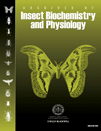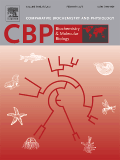
PHYSIOLOGICAL AND BIOCHEMICAL ZOOLOGY
Scope & Guideline
Advancing Knowledge in Physiology and Biochemistry
Introduction
Aims and Scopes
- Physiological Ecology:
The journal emphasizes studies that explore the physiological adaptations of animals to their environments, including temperature regulation, metabolic responses, and energy allocation strategies. - Biochemical Processes:
Research on the biochemical mechanisms underlying physiological functions is a core focus, including studies on metabolism, hormonal regulation, and cellular responses to stress. - Comparative Physiology:
The journal frequently publishes comparative studies that examine physiological traits across different species, providing insights into evolutionary adaptations and functional diversity. - Environmental Stress Responses:
A significant area of interest is how various environmental stressors—such as temperature extremes, hypoxia, and pollutants—affect animal physiology and behavior. - Developmental Physiology:
The journal also covers research on developmental changes in physiology, particularly how early-life conditions influence growth, metabolism, and later-life performance.
Trending and Emerging
- Physiological Responses to Climate Change:
There is an increasing focus on how climate change affects physiological traits in various species, including adaptations to extreme temperatures and altered metabolic processes. - Integrative Approaches Combining Genomics and Physiology:
Recent studies are trendily employing genomics alongside physiological assessments, indicating a move towards understanding the genetic basis of physiological traits and responses. - Health and Disease in Wildlife:
Emerging themes include the physiological impacts of disease and infection on wildlife, reflecting a growing interest in conservation physiology and the health of ecosystems. - Behavioral Physiology and Ecology:
There is a rising trend in research exploring the physiological underpinnings of behavior, particularly in relation to stress responses and reproductive strategies. - Metabolic Phenotyping:
Research focusing on metabolic phenotypes and their ecological implications is becoming more prominent, linking individual metabolic traits to broader ecological and evolutionary questions.
Declining or Waning
- Traditional Morphological Studies:
There has been a noticeable decrease in studies focusing solely on morphological traits without integrating physiological or biochemical analyses, indicating a shift towards more integrative approaches. - Static Laboratory Studies:
Research that relies heavily on static laboratory conditions is becoming less frequent, as there is a growing emphasis on field-based studies that consider dynamic interactions with the environment. - Generalized Ecological Models:
Papers that utilize broad ecological models without specific physiological or biochemical context are less common, suggesting a trend towards more nuanced and mechanistic approaches in ecological physiology.
Similar Journals

ARCHIVES OF INSECT BIOCHEMISTRY AND PHYSIOLOGY
Exploring the Intricacies of Insect Life at the Molecular LevelArchives of Insect Biochemistry and Physiology, an esteemed journal published by WILEY, stands at the forefront of advancing the understanding of insect physiology and biochemistry. With an ISSN of 0739-4462 and E-ISSN of 1520-6327, this journal serves as a critical resource for researchers and professionals in the fields of biochemistry, insect science, and physiology. As of 2023, it holds a respectable impact factor with a Q3 ranking in Biochemistry and Physiology, and a Q2 in Insect Science, highlighting its relevant contributions to these disciplines. The journal has maintained a continuous publication history from 1983 to 2024, hosting pioneering research and review articles that inform both academic and practical applications in entomology. While it does not currently offer open access, it is accessible through various institutional subscriptions, ensuring widespread availability of essential findings. This journal plays a vital role in elucidating the complex biochemical pathways and physiological adaptations of insects, fostering knowledge that is crucial for ecological research, agricultural development, and conservation efforts.

JOURNAL OF INSECT PHYSIOLOGY
Decoding the Complexities of Insect PhysiologyThe Journal of Insect Physiology, an esteemed publication by Pergamon-Elsevier Science Ltd, stands at the forefront of the study of insect biology and physiology. Established in 1957 and set in the United Kingdom, this journal has consistently contributed to advancing our understanding of the intricate physiological processes of insects throughout its converged years ending in 2024. With an impressive impact factor that solidifies its reputation, it ranks in the 1st quartile for Insect Science and the 2nd quartile for Physiology as per the 2023 metrics. The journal's Scopus rankings also reflect its influence, boasting a notable position in both Agricultural and Biological Sciences and Biochemistry, Genetics, and Molecular Biology. Although currently not open access, it provides researchers and professionals with invaluable insights and groundbreaking research essential for the field. With its comprehensive scope, the Journal of Insect Physiology is dedicated to fostering scientific dialogue and innovation, making it an indispensable resource for scholars and students alike.

JOURNAL OF PHYSIOLOGY-LONDON
Connecting History with Future Discoveries in PhysiologyJOURNAL OF PHYSIOLOGY-LONDON, published by WILEY, stands as a prestigious beacon in the fields of Physiology and Sports Science. Established in 1878, this journal has a rich history of disseminating crucial research findings and advancing scientific knowledge, continuing its impact into the present day with an anticipated convergence in 2024. Recognized for its excellence, it ranks in the Q1 category for both Physiology and Sports Science in 2023, cementing its position within the top echelons of academic publications. With a Scopus rank of #26 out of 193 in the Biochemistry, Genetics and Molecular Biology _ Physiology category, the journal boasts an impressive 86th percentile, reflecting its high-quality contributions to the scientific community. Although not open access, its extensive archive and reputation ensure that it remains a vital resource for researchers, professionals, and students eager to stay at the forefront of physiological science. For those looking to deepen their understanding of physiological mechanisms and their applications, the JOURNAL OF PHYSIOLOGY-LONDON is an indispensable resource.

RUSSIAN JOURNAL OF PLANT PHYSIOLOGY
Connecting Scholars to the Heart of Plant PhysiologyRUSSIAN JOURNAL OF PLANT PHYSIOLOGY, an esteemed publication with ISSN 1021-4437 and E-ISSN 1608-3407, is dedicated to advancing knowledge in the field of plant science. Published by PLEIADES PUBLISHING INC in the United States, this journal serves as a critical platform for researchers, professionals, and students aiming to explore the intricacies of plant physiology, biochemistry, and environmental interactions. With a consistent output from 1996 to 2024, the journal holds a commendable position within the academic community, reflected in its Q3 ranking among 516 journals in the Plant Science category (2023) and a competitive 44th percentile ranking in the Scopus database. Although the journal is not Open Access, it continues to attract a diverse readership of scholars eager to publish groundbreaking research. It stands out as a vital resource for anyone engaged in understanding the physiological processes that underpin plant life, thereby contributing to global agricultural advancements and ecological sustainability.

Frontiers in Physiology
Connecting global scholars through open-access discoveries.Frontiers in Physiology, published by FRONTIERS MEDIA SA, is a leading open-access journal that has been at the forefront of physiological research since its inception in 2010. As a reputable publication based in Switzerland, it aims to foster the dissemination of groundbreaking findings across various domains of physiology, engaging a global audience of scholars and practitioners. With a commendable Q2 ranking in the fields of both general physiology and medical physiology for 2023, this journal stands out in its field, achieving a significant Scopus rank of #32/113 in medical physiology and #58/193 in biochemistry, genetics, and molecular biology. Frontiers in Physiology not only commits to maintaining high scholarly standards but also ensures that all its articles are freely accessible, thereby promoting collaborative knowledge exchange. With a clear focus on advancing our understanding of physiological processes, the journal plays a crucial role in the development of innovative approaches to health and disease, making it an essential resource for researchers, professionals, and students alike.

Conservation Physiology
Advancing ecological insights for a sustainable future.Conservation Physiology is a premier scholarly journal published by Oxford University Press, dedicated to advancing the understanding of physiological processes in the context of conservation and environmental science. Established in 2013 as an Open Access platform, it has rapidly gained recognition within the academic community, featuring research that spans various critical areas such as ecological modeling, management, monitoring, policy, and law. With its impressive impact in the field, Conservation Physiology holds a notable rank in Scopus and boasts quartile distinctions, reflecting its influence and contribution to Nature and Landscape Conservation. This journal serves as a vital resource for researchers, professionals, and students engaged in conservation efforts, providing them with a comprehensive understanding of how physiological insights inform effective conservation strategies and policies. Through its commitment to open access, Conservation Physiology ensures that vital research is readily available, fostering collaboration and innovation in the pursuit of global ecological sustainability.

JOURNAL OF EVOLUTIONARY BIOCHEMISTRY AND PHYSIOLOGY
Exploring the Nexus of Biochemistry and Evolutionary DynamicsJOURNAL OF EVOLUTIONARY BIOCHEMISTRY AND PHYSIOLOGY, published by PLEIADES PUBLISHING INC, is a pivotal periodical that delves into the intricate relationships between biochemical processes and evolutionary dynamics. With its ISSN 0022-0930 and E-ISSN 1608-3202, this journal serves as a comprehensive platform for researchers, professionals, and students dedicated to understanding the physiological adaptations and biochemical mechanisms influenced by evolutionary pressures. Although it is not an open access journal, it offers valuable insights across its historically significant coverage spanning from 1972 to 2017, making it an essential resource for those working in agricultural, biological, and molecular sciences. Despite its current Scopus rankings revealing limited visibility within its fields, the journal remains committed to fostering scholarly dialogue and advancing knowledge in the realm of evolutionary biochemistry, especially for those exploring the ecological, genetic, and integrative physiological aspects of life.

COMPARATIVE BIOCHEMISTRY AND PHYSIOLOGY B-BIOCHEMISTRY & MOLECULAR BIOLOGY
Advancing Knowledge in Comparative BiochemistryComparative Biochemistry and Physiology B: Biochemistry & Molecular Biology, published by Elsevier Science Inc, is a premier journal dedicated to the field of biochemistry and molecular biology with a specific focus on comparative analyses across various biological systems. Since its inception in 1971, the journal has made significant contributions to our understanding of the biochemical and physiological processes that differentiate organismal function across animal and aquatic life. The journal holds a commendable position in the academic community, evidenced by its 2023 rankings, which place it in the second quartile for Animal Science and Zoology and Aquatic Science, and the third quartile for both Biochemistry and Molecular Biology as well as Physiology. Researchers and students can access cutting-edge research through this highly respected publication, which continues to influence the future of biological sciences. While currently not an Open Access journal, its rigorous peer-review process ensures that only high-quality articles are disseminated, further solidifying its role as a critical resource for professionals and academics alike seeking to explore the intricate relationships between biochemical structures and physiological functions.

PHYSIOLOGIA PLANTARUM
Charting New Territories in Plant Research and GeneticsPHYSIOLOGIA PLANTARUM, published by WILEY, is a prestigious journal in the fields of plant science, physiology, and genetics, known for its impactful contributions since its inception in 1948. With an impressive impact factor and a consistent ranking in the Q1 and Q2 quartiles, it stands out in critical disciplines such as cell biology and biochemistry, ranking #24 in Plant Science with a remarkable 95th percentile standing. This journal primarily serves researchers and professionals committed to advancing the understanding of plant functions, responses, and their molecular mechanisms. Its broad scope allows for a diverse array of studies, ensuring that groundbreaking research is accessible to the global scientific community. Although it does not offer Open Access, PHYSIOLOGIA PLANTARUM remains a vital resource for scholars looking to stay at the forefront of plant biology and related fields.

PHYSIOLOGY & BEHAVIOR
Bridging the Gap Between Neuroscience and PsychologyPHYSIOLOGY & BEHAVIOR, published by Pergamon-Elsevier Science Ltd, is a premier journal that has been illuminating the intersections of physiological and behavioral research since its inception in 1966. With a promising impact reflected in its 2023 category quartiles— ranking Q2 in both Behavioral Neuroscience and Experimental and Cognitive Psychology, and a prior Q1 in Philosophy—this journal stands at the forefront of multidisciplinary research. It holds respectable ranks within the Scopus database, placing 27th out of 165 in Experimental Psychology and 25th out of 88 in Behavioral Neuroscience, highlighting its significant contribution to the academic community. The journal encourages the dissemination of high-quality research objectives that explore the intricate connections between behavior and biological processes, making it a vital resource for researchers, professionals, and students alike. Although access is not currently open, the journal continues to provide deep insights into crucial developments in its field, ensuring its readers stay updated on the latest scientific advancements.